3D Modeling of the Solidification Structure Evolution and of the Inter Layer/Track Voids Formation in Metallic Alloys Processed by Powder Bed Fusion Additive Manufacturing
Abstract
1. Introduction
2. General Methodology and Procedure: Multi-Scale Modelling Approach
3. Results and Discussion
4. Computational Details
- The CUDA 3D-Micro simulator is at least one order of magnitude faster than the CPU Micro-3D simulator using the Intel Skylake AL supercomputer;
- The CPU 3D-Micro simulator is fairly fast, typically taking about 1 h for a 3-multilayer 5-multitrack simulation using a 1 μm mesh size (46 million cells, RAM 8 GB);
- The CPU 3D-Micro simulator can run ~3 trillion cells on the Intel Skylake AL supercomputer (RAM 500 GB), which is equivalent of a 2.9 mm3 geometry using a 2 μm mesh size.
5. Concluding Remarks
Funding
Institutional Review Board Statement
Informed Consent Statement
Acknowledgments
Conflicts of Interest
References
- Balbaa, M.; Mekhiel, S.; Elbestawi, M.; McIsaac, J. On selective laser melting of Inconel 718: Densification, surface roughness, and residual stresses. Mater. Des. 2020, 193, 108818. [Google Scholar] [CrossRef]
- Choi, J.P.; Shin, G.H.; Yang, S.; Yang, D.Y.; Lee, J.-S.; Brochu, M.; Yu, J.H. Densification and microstructural investigation of Inconel 718 parts fabricated by selective laser melting. Powder Technol. 2017, 310, 60–66. [Google Scholar] [CrossRef]
- Kumar, P.; Farah, J.; Akram, J.; Teng, C.; Ginn, J.; Misra, M. Influence of laser processing parameters on porosity in Inconel 718 during additive manufacturing. Intern. J. Adv. Manuf. Technol. 2019, 103, 1497–1507. [Google Scholar] [CrossRef]
- Huynh, T.; Mehta, A.; Graydon, K.; Woo1, J.; Park, S.; Hyer, H.; Zhou, L.; Imholte, D.D.; Wachs, N.E.W.D.M.; Sohn, Y. Microstructural Development in Inconel 718 Nickel-Based Superalloy Additively Manufactured by Laser Powder Bed Fusion. Metallogr. Microstruct. Anal. 2022, 11, 88–107. [Google Scholar] [CrossRef]
- Mukherjee, T.; Wei, H.L.; De, A.; DebRoy, T. Heat and fluid flow in additive manufacturing–Part II: Powder bed fusion of stainless steel, and titanium, nickel and aluminum base alloys. Comput. Mater. Sci. 2018, 150, 369–380. [Google Scholar] [CrossRef]
- Gan, Z.; Jones, K.K.; Lu, Y.; Liu, W.K. Benchmark study of melted track geometries in laser powder bed fusion of inconel 625. Integr. Mater. Manuf. Innov. 2021, 10, 177–195. [Google Scholar] [CrossRef]
- Lian, Y.; Gan, Z.; Yu, C.; Kats, D.; Liu, W.K.; Wagner, G.J. A cellular automaton finite volume method for microstructure evolution during additive manufacturing. Mater. Des. 2019, 69, 107672. [Google Scholar] [CrossRef]
- Kats, D.; Wang, Z.; Gan, Z.; Liu, W.K.; Wagner, G.J.; Lian, Y. A physics-informed machine learning method for predicting grain structure characteristics in directed energy deposition. Comput. Mater. Sci. 2022, 202, 110958. [Google Scholar] [CrossRef]
- Nastac, L. Modeling and Simulation of Microstructure Evolution in Solidifying Alloys, a Monograph; Springer: New York, NY, USA, 2004; Available online: http://www.springer.com/materials/special+types/book/978-1-4020-7831-6 (accessed on 1 November 2022). [CrossRef]
- Nastac, L. A multiscale transient modeling approach for predicting the solidification structure in VAR-processed alloy 718 ingots. Metall. Mater. Trans. B 2014, 45, 44–50. [Google Scholar] [CrossRef]
- Nastac, L. 3D Modeling of the Solidification Structure Evolution of Superalloys in Powder Bed Fusion Additive Manufacturing Processes. Metals 2021, 11, 1995. [Google Scholar] [CrossRef]
- Turner, J.S. Buoyancy Effects in Fluids; Cambridge University Press: Cambridge, UK, 1973; ISBN 978-0-521-08623-3. [Google Scholar]
- Khairallah, S.A.; Anderson, A.T.; Rubenchik, A.; King, W.E. Laser powder-bed fusion additive manufacturing: Physics of complex melt flow and formation mechanisms of pores, spatter, and denudation zones. Acta Mater. 2016, 18, 36–45. [Google Scholar] [CrossRef]
- Goldak, J.; Chakravarti, A.; Bibby, M. A new finite element model for welding heat sources. Metall. Trans. B 1984, 15, 299–305. [Google Scholar] [CrossRef]
- 2018 AM-Bench Test Descriptions for AMB2018-02, NIST. Available online: https://www.nist.gov/ambench/amb2018-02-description (accessed on 8 November 2022).
- Rolchigo, M.; Stump, B.; Belak, J.; Plotkowski, A. Sparse thermal data for cellular automata modeling of grain structure in additive manufacturing. Model. Simul. Mater. Sci. Eng. 2020, 28, 065003. [Google Scholar] [CrossRef]
- Koepf, J.A.; Gotterbarm, M.R.; Markl, M.; Koerner, C. 3D multi-layer grain structure simulation of powder bed fusion additive manufacturing. Acta Mater. 2018, 152, 119–126. [Google Scholar] [CrossRef]
- Rodgers, T.M.; Madison, J.D.; Tikare, V. Simulation of metal additive manufacturing microstructures using kinetic Monte Carlo. Comput. Mater. Sci. 2017, 135, 78–89. [Google Scholar] [CrossRef]
- Nastac, L.; Chou, J.-S.; Pang, Y. Assessment of Solidification-Kinetics Parameters for Titanium-Base Alloys. In Proceedings of the International Symposium on Liquid Metals Processing and Casting, Vacuum Metallurgy Conference, Santa Fe, NM, USA, 20–24 February 1999; pp. 207–233. [Google Scholar]
- Stefanescu, D.M. Science and Engineering of Casting Solidification; Springer: New York, NY, USA, 2009. [Google Scholar]
- Aziz, M.J. Model for solute redistribution during rapid solidification. J. Appl. Phys. 1982, 53, 1158–1168. [Google Scholar] [CrossRef]
- Baker, J.C.; Cahn, J.W. Solidification; ASM Metals Park: Cleveland, OH, USA, 1971; p. 23. [Google Scholar]
- Nguyen, Q.B.; Nai, M.L.S.; Zhu, Z.; Sun, C.N.; Wei, J.; Zhou, W. Characteristics of inconel powders for powder-bed additive manufacturing. Engineering 2017, 3, 695–700. [Google Scholar] [CrossRef]
- Thermo-Physical Properties of Ar. Available online: https://webbook.nist.gov/ (accessed on 3 November 2022).
- Wei, L.C.; Ehrlich, L.E.; Palm, M.J.P.; Montgomery, C.; Beuth, J.; Malen, J.A. Thermal conductivity of metal powders for powder bed additive manufacturing. Addit. Manuf. 2018, 21, 201–208. [Google Scholar] [CrossRef]
- America Makes. Air Force Research Laboratory (AFRL) Additive Manufacturing Modeling Challenge Series 2. 2019. Available online: https://materials-data-facility.github.io/MID3AS-AM-Challenge/Challenge2ProblemStatement_2019Release.pdf (accessed on 3 November 2022).
- Mills, K.C. Recommended Values of Thermo-Physical Properties for Selected Commercial Alloys; Woodhead Publishing: Cambridge, UK, 2002. [Google Scholar]
- Pottlacher, G.; Hosaeus, H.; Kaschnitz, E.; Seifter, A. Thermophysical properties of solid and liquid Inconel 718 Alloy. Scand. J. Metall. 2002, 31, 161–168. [Google Scholar] [CrossRef]
- Agazhanov, A.S.; Samoshkin, D.A.; Kozlovskii, Y.M. Thermophysical properties of Inconel 718 alloy. J. Phys. Conf. Ser. 2019, 1382, 012175. [Google Scholar] [CrossRef]
- Valencia, J.J.; Quested, P.N. ASM Handbook: Casting, ASM Handbook Committee; ASM International: Almere, The Netherlands, 2008; Volume 15, pp. 468–481. [Google Scholar]
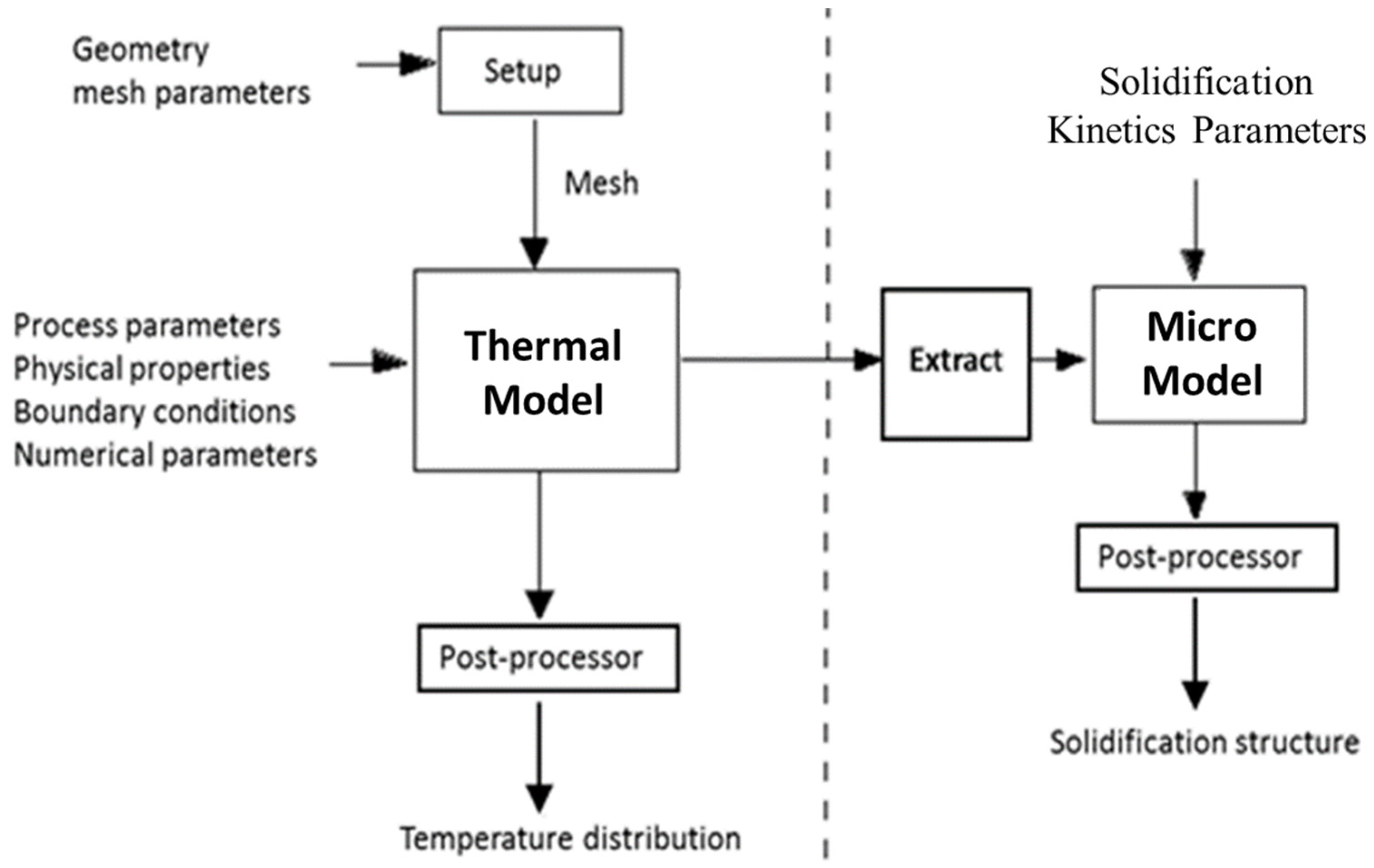

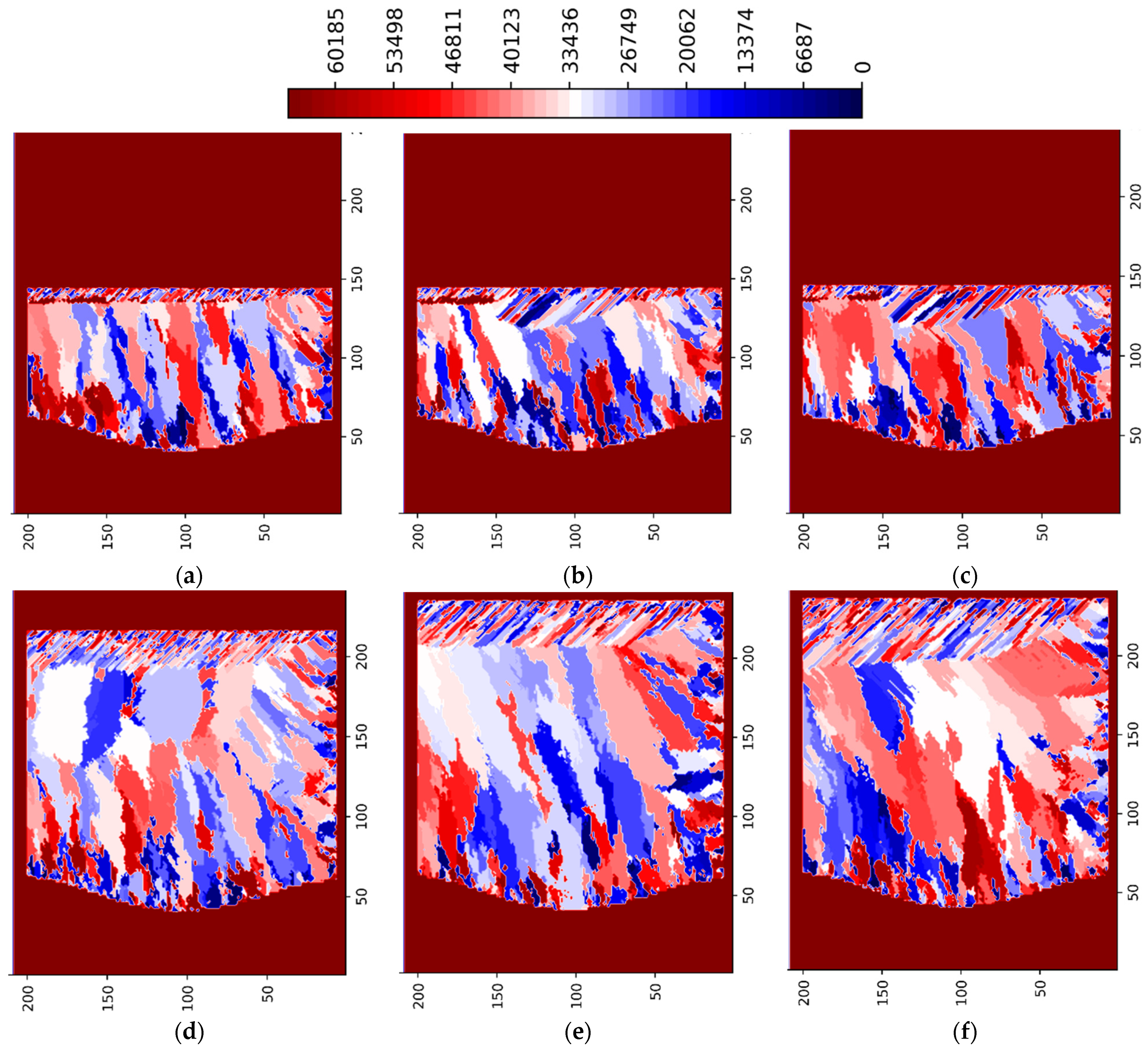
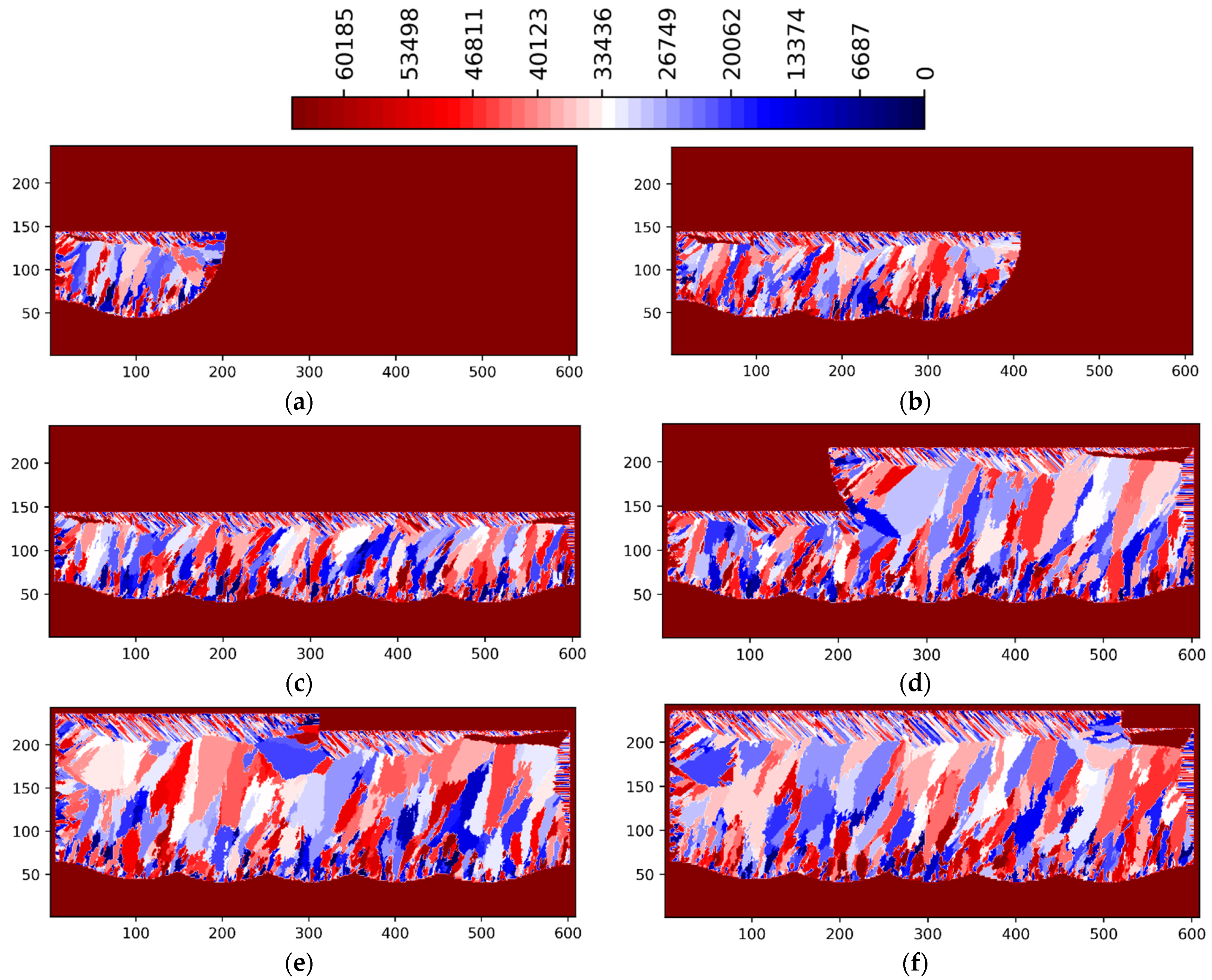
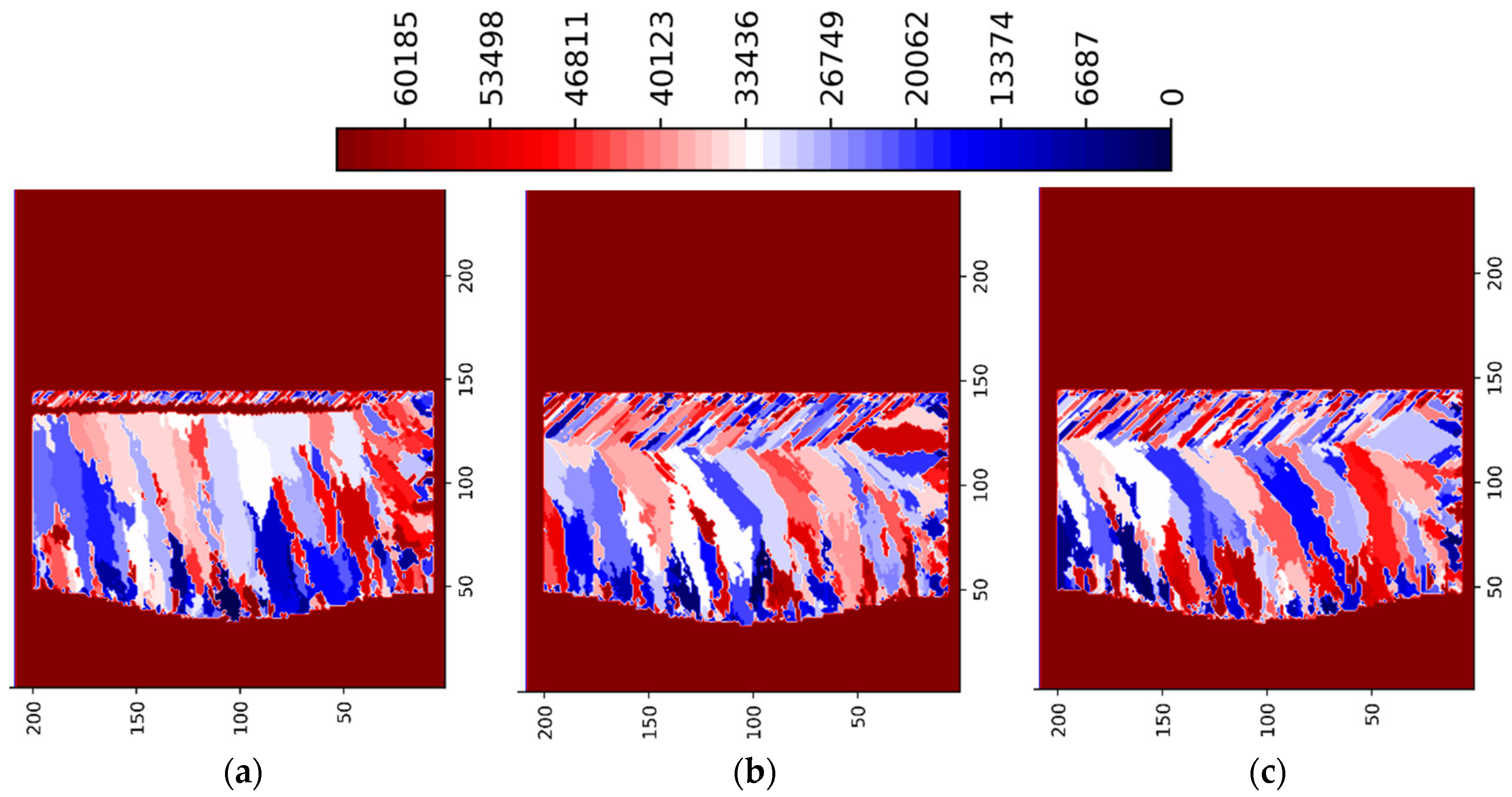
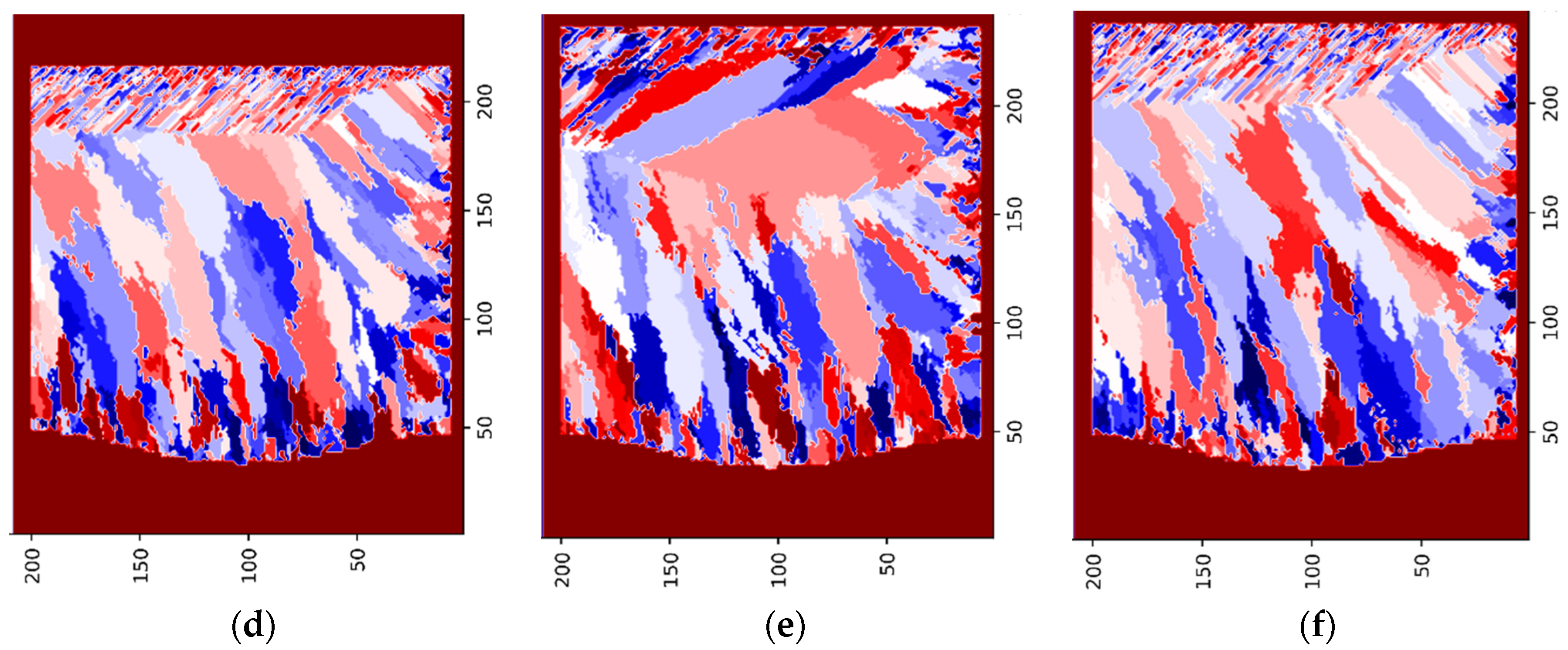
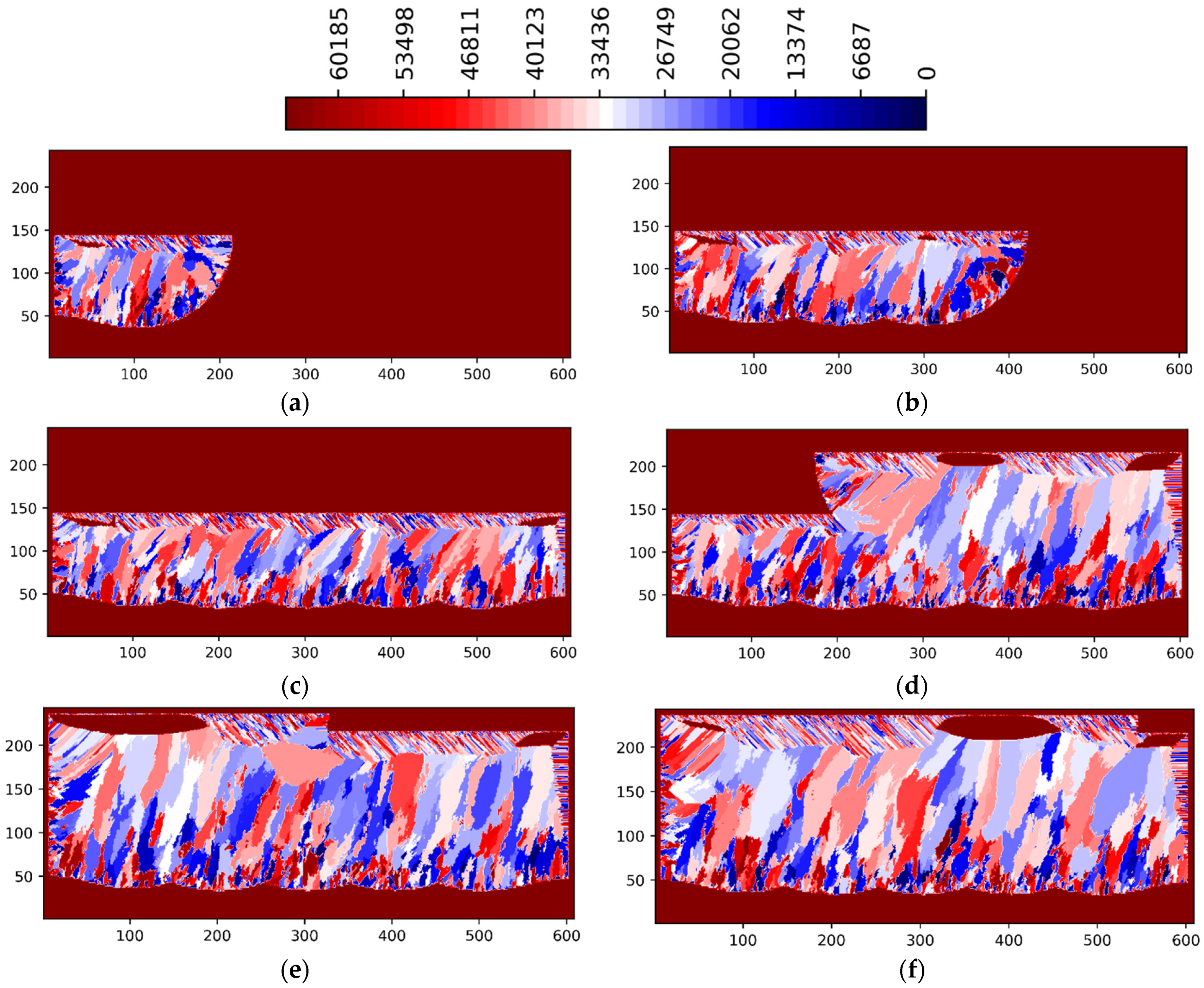
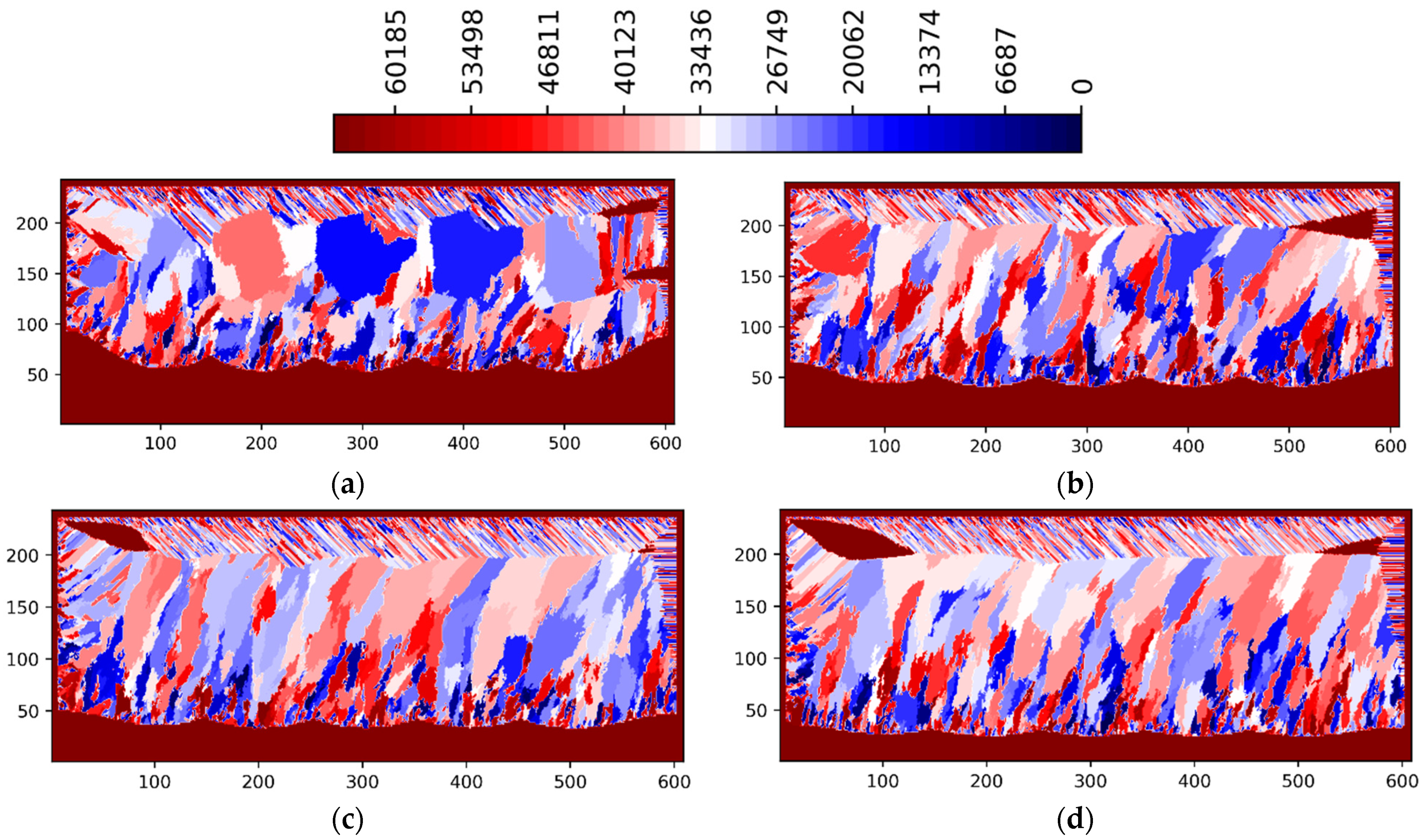
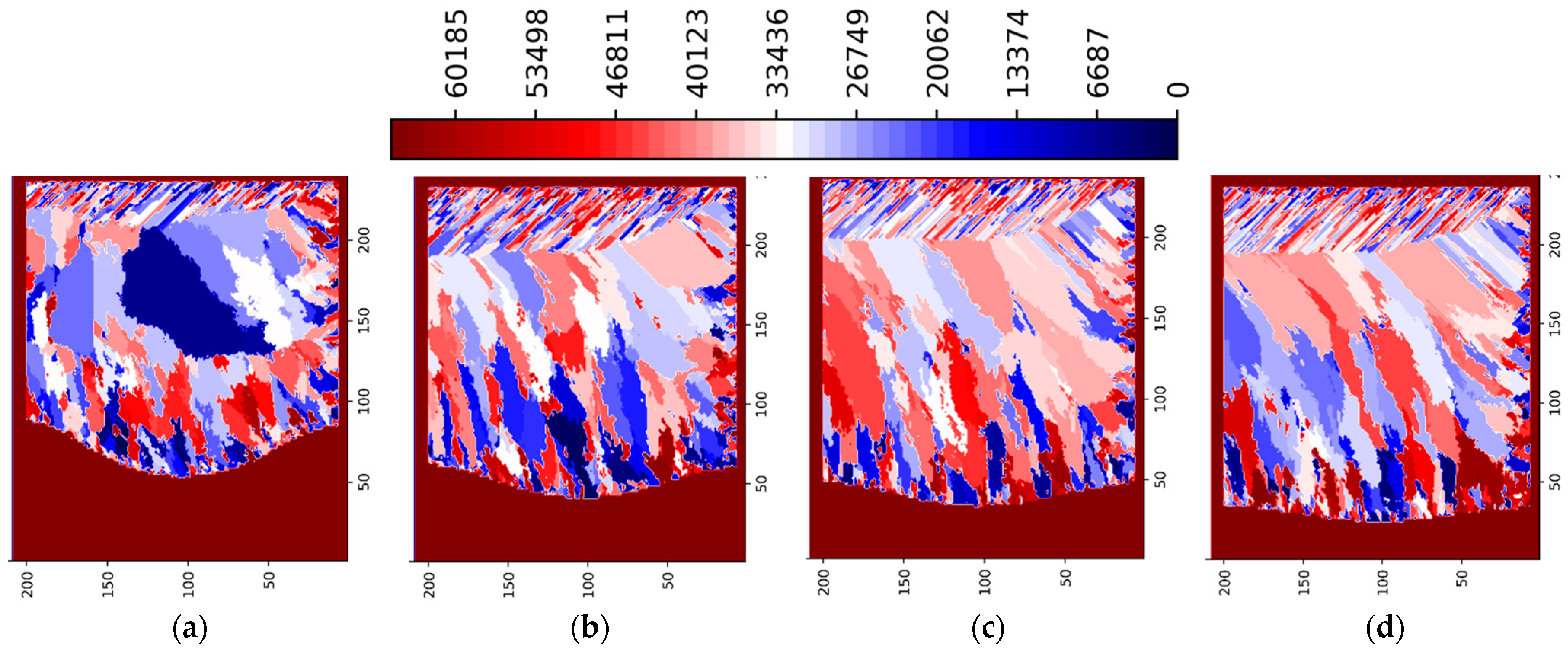
| Property | Value | Unit |
|---|---|---|
| ρS | 8303.7 − 0.3622 T − 5 × 10−5 T2 | kg/m3 |
| ρL | 8366 − 0.488 T | kg/m3 |
| cpS | 305.72 + 0.3657 T − 8 × 10−5 T2 | J/kg/K |
| cpL | 720 | J/kg/K |
| KS | 3.8595 + 0.0208 T − 4 × 10−6 T2 | W/m/K |
| KL | 4.8985 + 0.0136 T | W/m/K |
| L | 2.95 × 105 | J/kg |
| mL | −10.5 | K/wt.% |
| Γ | 3.65 × 10−7 | K/m |
| DL | 3.0 × 10−9 | m2/s |
| ke | 0.48 | |
| 1609.15 | K | |
| 1459.15 | K | |
| 1.0 × 1010 | m−2 |
| Parameter | Value | Unit |
|---|---|---|
| P | 125, 188, 250 and 375 | W |
| Vs | 0.8 | m/s |
| σ | 50 | μm |
| A | 0.3 | - |
| Δt | 2.0 × 10−5 | s |
| 298.15 | K |
Publisher’s Note: MDPI stays neutral with regard to jurisdictional claims in published maps and institutional affiliations. |
© 2022 by the author. Licensee MDPI, Basel, Switzerland. This article is an open access article distributed under the terms and conditions of the Creative Commons Attribution (CC BY) license (https://creativecommons.org/licenses/by/4.0/).
Share and Cite
Nastac, L. 3D Modeling of the Solidification Structure Evolution and of the Inter Layer/Track Voids Formation in Metallic Alloys Processed by Powder Bed Fusion Additive Manufacturing. Materials 2022, 15, 8885. https://doi.org/10.3390/ma15248885
Nastac L. 3D Modeling of the Solidification Structure Evolution and of the Inter Layer/Track Voids Formation in Metallic Alloys Processed by Powder Bed Fusion Additive Manufacturing. Materials. 2022; 15(24):8885. https://doi.org/10.3390/ma15248885
Chicago/Turabian StyleNastac, Laurentiu. 2022. "3D Modeling of the Solidification Structure Evolution and of the Inter Layer/Track Voids Formation in Metallic Alloys Processed by Powder Bed Fusion Additive Manufacturing" Materials 15, no. 24: 8885. https://doi.org/10.3390/ma15248885
APA StyleNastac, L. (2022). 3D Modeling of the Solidification Structure Evolution and of the Inter Layer/Track Voids Formation in Metallic Alloys Processed by Powder Bed Fusion Additive Manufacturing. Materials, 15(24), 8885. https://doi.org/10.3390/ma15248885






